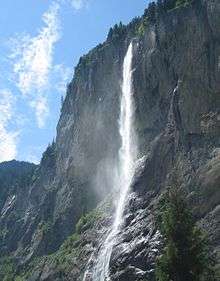Staubbach Falls
The Staubbach Fall (German: Staubbachfall (sing.), lit.: dust creek fall) is a waterfall in Switzerland, located just west above Lauterbrunnen in the Bernese Highlands. The waterfall drops 297 metres (974 ft) from a hanging valley that ends in overhanging cliffs above the Weisse Lütschine.[1]

The stream, on reaching the verge of the rocky walls of the valley, forms a cascade so high that it is almost lost in spray before it reaches the level of the valley. After rain, and early in the season when fed by the melting snows, the Staubbach Fall is a very striking object. The force of the stream above the fall at such times is sufficient to carry the water clear of the precipice, and the whole mass descends in a condition of liquid dust, between spray and cloud, that sways to-and-fro with the gentlest breeze. In a dry summer, when the supply of water is much reduced, the effect is comparatively insignificant.[2]
A visit by Johann Wolfgang von Goethe in 1779 provided the inspiration for his poem "Gesang der Geister über den Wassern".
The falls were featured on the Swiss 3-centime postage stamp of the 1930s.
See also
- Trümmelbach Falls - Another notable waterfall in the Lauterbrunnen valley
References
- Geographen Christian Schwick + Florian Spichtig (eds.). "Wasserfall-DB". waterfall.ch (in German). Zurich, Switzerland: Schweizerische Greina-Stiftung (SGS). Retrieved 2017-07-11.CS1 maint: uses editors parameter (link)
- John Ball, The Alpine Guide, Central Alps, p. 75, 1866, London